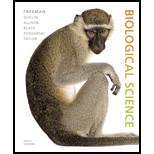
Concept explainers
What is a sieve-tube element?
a. the sugar-conducting cell found in phloem
b. the widened, perforation-containing, water-conducting cell found only in
c. the nutrient- and water-absorbing cell found in root hairs
d. the nucleated and organelle-rich support cell found in phloem
Introduction:
The plants consist of two important tissues, namely, phloem and xylem. Phloem is responsible for the transfer of organic molecules across different cells in the plants. Sieve-tube cells are the specialized cells that are present in the phloem tissue for the transport of carbohydrates.
Answer to Problem 1TYK
Correct answer:
The sieve-tube cells or the sieve-tube elements are the dead, elongated cells found in the phloem of the angiosperms. These elements carry out the transfer of sugar in the plants.
Explanation of Solution
Explanation/Justification for the correct answer:
Option (a) is given as the cell that is responsible for the conduction of sugars. The sieve-tube elements are the specialized cells involved in the conduction of the sugars in the plants. Carbohydrate (starch) is one such form of sugar. On maturity, they are considered as dead cells due to lack of nucleus. These cells are present in the phloem of the angiosperms. Hence, Option (a) is correct.
Explanation for incorrect answer:
Option (b) is given as the widened, perforation-containing, water-conducting cell found only in angiosperms. The perforation-containing, widened cells that carry out transport of water are known as xylem. So, it is a wrong answer.
Option (c) is given as cells that are found in the root hairs and are responsible for the absorption of water and nutrients. The roots hairs are also known as trichoblasts. The trichoblast is formed from the epidermis layer of the root of the plant. So, it is a wrong answer.
Option (d) is given as the nucleated and organelle-rich cells found in phloem. The nucleated and organelle-rich support cells in the phloem are also known as companion cells. The companion cells are those that transport the sugar to the sieve-tube elements in the leaves from the mesophyll. So, it is a wrong answer.
Hence, options (b), (c), and (d) are incorrect.
Thus, sieve–tube cells represent the class of cells that are specialized for the transportation of sugar in the plants and are found in the phloem.
Want to see more full solutions like this?
Chapter 34 Solutions
Biological Science (6th Edition)
- Which cells are responsible for the movement of photosynthates through a plant? a. tracheids, vessel elements b. tracheids, companion cells c. vessel elements, companion cells d. sieve-tube elements, companion cellsarrow_forwardWhat is the function of the lenticels? Do all stems have lenticels? How can you differentiate a monocot plant from a dicot plant just by looking at the stem? What advantage would herbaceous stems have over woody stems?arrow_forwardPrimary phloem develops from: A. lateral meristem B. protoderm C. extrastelar cambium D. provascular tissuearrow_forward
- This model represents which stem: Monocot or Eudicot Label the following As A-E -Sclerenchyma fibers -Xylem -Epidermis -Phloem -Vascular bundlearrow_forwardChoose the incorrect statement: a. Fusiform and ray initials are formed by the vascular cambium. b. The cork cambium produces the periderm layer, a thicker tougher outer layer that replaces the epidermis. c. Wood is composed of secondary xylem. d. The vascular cambium separates the xylem on the outside of the stem and the phloem on the inside.arrow_forwardWhat plant tissue has cells that are dead at maturity? a. Xylem c. Ground b. Phloem d. Dermalarrow_forward
- 31. what meristematic area produces parenchyma cells of the cortex a. protoderm b. pith c. ground meristem d. procambium 32. this meristematic area produces the primary xylem and primary phloem a. procambium b. ground meristem c. protoderm d. pitharrow_forwardDo all dicot seeds have endosperm? Explain your answer.arrow_forwardWhich type of Stem modification is seen in banana ? A) Rhizome B) Stem tuber C) Corn D) Bulbarrow_forward
- Gymnosperm A) How are the seeds of pine trees dispersed away from the parent plant? b) Suggest an advantage of dispersing seeds away from parent plants.arrow_forwardDo monocot stems have petioles? Explain your answer.arrow_forwardGuttation in plants is due to condensation of water vapor and occurs through the hydathodes. D. Disagree, because guttation occurs through the stomates. A. Agree, because guttation occurs through the hydathodes. B. Disagree, because it is root pressure that causes guttation. C. Agree, because during night time, water condenses due to drop in temperature.arrow_forward
 Concepts of BiologyBiologyISBN:9781938168116Author:Samantha Fowler, Rebecca Roush, James WisePublisher:OpenStax College
Concepts of BiologyBiologyISBN:9781938168116Author:Samantha Fowler, Rebecca Roush, James WisePublisher:OpenStax College Biology (MindTap Course List)BiologyISBN:9781337392938Author:Eldra Solomon, Charles Martin, Diana W. Martin, Linda R. BergPublisher:Cengage Learning
Biology (MindTap Course List)BiologyISBN:9781337392938Author:Eldra Solomon, Charles Martin, Diana W. Martin, Linda R. BergPublisher:Cengage Learning


